 Paycheck
Paycheck
A
Movie Review By Gokhra
IT
is a sci-fi movie that has something vaguely to do with time travel
except that no one really travels trough time. It about seeing the
future and doing all sorts of things, so the main character has a
life altering experience. So far, so typical. The difference is that
there is a twist here where the hero has amnesia. The twist is that
he is not trying to remember the past but the future.
Ben Affleck plays
Michael Jennings who is a reverse engineer. What he does is take hold
of any new technology and take it apart. Although it sounds like the
antics of a two-year-old, Affleck's character can also rebuild the
devices so that they are much better than the originals. Its all about
avoiding copyright laws to cash in on someone else's invention but
copying, modifying and fitting.
These jobs are
so top secret that Affleck is dealt a sneaky contract clause where
he sort of agrees that all his memories will be erased concerning
the job. He wakes up after every job with a week or so missing and
a huge paycheque in his bank account. This is all sort of okay because
money speaks.
 All
this changed, though when he took on a new job where he would have
to work for three years and he would forget. Of course as money talks
this would have been okay but the directors needed a story and here
it is. Jennings woke up one day to realise that he does not know what
he has done the last three years and to make matter worse he seems
to have forfeited a $90 million deal.
All
this changed, though when he took on a new job where he would have
to work for three years and he would forget. Of course as money talks
this would have been okay but the directors needed a story and here
it is. Jennings woke up one day to realise that he does not know what
he has done the last three years and to make matter worse he seems
to have forfeited a $90 million deal.
Of course, you
cannot have a device that can see through time and not take a peek
yourself. Jennings took a look into the future and knew what was going
to happen. So he left himself some clues which would help him overcome
the obstacles.
He discovered
that he had left himself an envelope full of strange objects, each
of which not only provides a clue to his erased past but is vital
to his survival. You get the whole story gradually. In the past three
years, Michael perfected a lens powerful enough to see past the curvature
of time into the future. So everything that happens to Michael, he
has already foreseen using his own super lens and has taken the precaution
to supply himself with everyday objects that will allow him to change
that future.
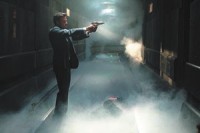 An
evil company called Alcom wants to use this machine to make money
by selling information to world leaders. As a result, the destruction
of the world is inevitable since they will know exactly wat their
opponent will do in the future. As if the end of the world is not
enough our hero also has a love interest in Rachel played by Uma Thurman.
This is a woman he has loved for the past three years but cannot remember
now. Just listen to the dialogues between the couple and you'll wonder
if nowadays romance is limited to short lines.
An
evil company called Alcom wants to use this machine to make money
by selling information to world leaders. As a result, the destruction
of the world is inevitable since they will know exactly wat their
opponent will do in the future. As if the end of the world is not
enough our hero also has a love interest in Rachel played by Uma Thurman.
This is a woman he has loved for the past three years but cannot remember
now. Just listen to the dialogues between the couple and you'll wonder
if nowadays romance is limited to short lines.
It's
really neat how Affleck's character works through the puzzles. One
of the contents in the envelope was a bus ticket, which he needed
just in time as a gang was chasing him. This is where you notice a
gaping plot hole. After changing the first thing in time every other
event should be different. Anyway it's an enjoyable movie. Not only
that, it's a John Woo movie meaning you get your full load of choreographed
action scenes, slow motion kicks and a motorbike chase scene involving
lots of bad guys in big black cars.
 Jensen
Ackles
Jensen
Ackles
Birth
Name: Jensen Ross Ackles. Date of birth: 1 March 1978, Dallas, Texas,
USA
Boyishly handsome
Texan Jensen Ackles began his career at age four, modelling in print
and TV ads for Wal-Mart, Nabisco and Radio Shack, but didn't begin
to fully realize his potential until fifteen years later, where he
broke hearts and won fans portraying Eric Brady on the NBC daytime
drama "Days of Our Lives" (from 1997 to 2000).
After his pre-school
foray in to the modelling world, Ackles stayed out of the spotlight
until 1995, when he was signed by an agent after being spotted at
a Dallas actors' workshop. His TV acting debut came shortly thereafter,
appearing in an episode of the Dallas-lensed PBS series "Wishbone",
starring a talking dog who acts out literary classics for kids. After
completing high school, Ackles moved to Los Angeles, where he landed
a guest role on "Sweet Valley High" (syndicated) and a regular
part on the high school-set sitcom "Mr. Rhodes" (NBC, 1996-97).
Though the series
was troubled from its beginnings and enjoyed only a short run, Ackles
used the part as an important jumping off point, and was soon essaying
the role of Eric on "Days of Our Lives". Walking in the
shoes of a character who hadn't been seen onscreen since infancy,
Ackles was a good counterpoint to his evil twin sister Sami (Alison
Sweeney), who shared his freshly-scrubbed, golden blond good looks,
but unconvincingly hid a poisoned heart. The far more sympathetic
and charming Eric quickly gained favor with fans of the soap.
Ackles left the
series in 2000, when his character's storylines stalled. He appeared
in the CBS 2001 miniseries "Blonde", based on Joyce Carol
Oates' fictionalized biography of Marilyn Monroe and that same year
became a series regular on the popular Fox sci-fi adventure series
"Dark Angel". Having first appeared on the series the season
year before as a doomed X5 escapee, Ackles reemerged as Alec, a genetically
engineered superhuman with a sarcastic sense of humor and a mysterious
background.
Since
Fox cancelled Dark Angel after two years, Ackles took on a recurring
role on WB's own, "Dawson's Creek", playing Michelle Williams'
love interest C.J., during its last season.
 Space
Telescope Sees Through Nebula
Space
Telescope Sees Through Nebula
The
heat-sensing infrared eyes of NASA's newest space telescope are giving
astronomers an unprecedented peek at newborn stars.
The
Spitzer Space Telescope took a closer look at the Tarantula Nebula,
a region of newborn stars located in the southern constellation of
Dorado in a nearby galaxy called the Large Magellanic Cloud, according
to a NASA press release on January 16.
"We
can now see the details of what's going on inside this active star-forming
region," said Bernhard Brandl, principal investigator for the
latest observations and an astronomer at both Cornell University,
Ithaca, N.Y., and the University of Leiden, the Netherlands.
The
only nebula outside our galaxy that can be seen with the naked eye,
this glowing cloud of gas and dust is one of the most dynamic star-forming
regions. It contains some of the most massive stars in the universe,
up to 100 times more massive than the sun.
Other
telescopes, such as the Hubble Space Telescope, have captured the
nebula's spidery filaments and its star-filled core. But none was
capable of fully penetrating its dust-enshrouded pockets of younger
stars until now.
The
new Spitzer image shows a more complete picture of this stellar nursery,
including a hollow cavity around the stars, where intense radiation
has blown away cosmic dust.
"You
can see a hole in the cloud as if a giant hair dryer blew away all
the gas and dust," said Brandl in the statement.
Launched
on Aug. 25, 2003, from Cape Canaveral Air Force Station, Fla., the
Spitzer Space Telescope is the fourth of NASA's Great Observatories.
Spitzer gives astronomers a powerful tool for hunting galaxies and
other celestial objects that formed relatively soon after the Big
Bang explosion that brought our universe into existence.
These
ancient objects are now so far away that their light has shifted into
the cool, long-wavelength realm of infrared radiation, the portion
of the electromagnetic spectrum stretching from about 1 micron to
200 microns.
Visible light, in comparison, is between 0.4 and 0.7 microns; X-ray
and gamma-ray radiation far shorter.
While
the other Great Observatories have probed the universe with visible
light (Hubble Space Telescope), gamma rays (Compton Gamma Ray Observatory)
and X-rays (Chandra X-ray Observatory), the Spitzer Space Telescope
observes the cosmos in the infrared.
Spitzer's
sensitive instruments allow it to sense infrared radiation, or heat,
from the most distant, cold and dust-obscured celestial objects such
as stellar dust discs that serve as planetary wombs.
By
Discovery News
PC Game Reviews
Journey to the
Center of the Earth
Gamespot
Rating: 6.1 in 10
Publisher: Viva Media. Developer: Micro Application. Genre: Adventure.
Release Date: Nov 3, 2003. Difficulty: Hard, Learning Curve: About
a half hour, Stability: Minor Problems. Requirements: 64 MB RAM, 16
MB VRAM, 700 MB disk space
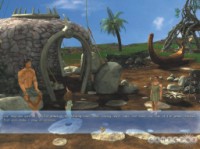 Journey
to the Center of the Earth has its heart in the right place. It's
an unpretentious point-and-click adventure game where you explore
an exotic world, collecting countless inventory items and solving
puzzles with them. From that perspective, fans of old-school adventures
should warm up to the game immediately. Then again, the game is marred
by bugs, design problems, low production values, and general sloppiness
that usually overshadow its genuine charms.
Journey
to the Center of the Earth has its heart in the right place. It's
an unpretentious point-and-click adventure game where you explore
an exotic world, collecting countless inventory items and solving
puzzles with them. From that perspective, fans of old-school adventures
should warm up to the game immediately. Then again, the game is marred
by bugs, design problems, low production values, and general sloppiness
that usually overshadow its genuine charms.
Journey to the
Center of the Earth is inspired by Jules Verne's classic novel of
the same name, but if you haven't read it, don't worry: The game's
story stands on its own. Taking part in a popular adventure game trend,
Journey puts you in the shoes of a young female character, in this
case a photojournalist named Ariane.
Ariane finds herself
in dire straits from the get-go. A helicopter sets her down by the
edge of a volcano in Iceland so she can take pictures. Soon after,
a rockslide destroys the chopper, and when Ariane ventures into a
nearby cave, she tumbles down into darkness.
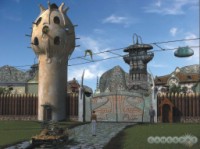 She
finds herself standing on a sunny beach, of all places. Talking to
a nearby stranger reveals that Ariane is now in a secret underground
world. It's your job to help her back to the surface while exploring
the mysteries of this secret world. Along the way, you'll find a forest
of giant mushrooms, tamed dinosaurs, a village of friendly giants,
and a quasi-Victorian city of the future that melds 1800s technology
with contemporary ideas like surveillance cameras and speedy cable
cars. Thanks to a laptop computer, Ariane gets occasional e-mails
updating her on the progress of her rescue party and other news from
topside. In the strange underground world, she becomes enmeshed in
a plot of manipulation and deceit with two possible endings: At a
vital juncture, choosing one path will cause the game to end rather
abruptly, but the other choice opens up another hour or two of gameplay.
She
finds herself standing on a sunny beach, of all places. Talking to
a nearby stranger reveals that Ariane is now in a secret underground
world. It's your job to help her back to the surface while exploring
the mysteries of this secret world. Along the way, you'll find a forest
of giant mushrooms, tamed dinosaurs, a village of friendly giants,
and a quasi-Victorian city of the future that melds 1800s technology
with contemporary ideas like surveillance cameras and speedy cable
cars. Thanks to a laptop computer, Ariane gets occasional e-mails
updating her on the progress of her rescue party and other news from
topside. In the strange underground world, she becomes enmeshed in
a plot of manipulation and deceit with two possible endings: At a
vital juncture, choosing one path will cause the game to end rather
abruptly, but the other choice opens up another hour or two of gameplay.
Despite all the
potential of the story and setting, they have about as much sophistication
as the '70s kids' TV show <>Land of the Lost. In fact, it can
be hard to tell if the game was intentionally geared toward kids or
is just very poorly written. Ariane mostly seems to take her fall
into another world inside the Earth in casual stride, and the inhabitants
of this lost world usually don't blink an eye at the intruder in their
realm. Most of the characters are paper thin, so don't expect the
sort of memorable, even touching, characters you find in smarter adventures
like Syberia or Broken Sword: The Sleeping Dragon. The setting is
a mishmash of ideas, and the dialogue is juvenile and stilted--imagine
a bad children's cartoon--to the point of eliciting laughter during
the serious bits.
Still,
if you can shut off your critical faculties and just go along for
the ride, Journey's world can be fun to explore. The game taps into
the perpetually enticing idea of some fantastic realm of adventure
lurking just behind the humdrum facade of everyday life.
Sinbad:
Legend of the Seven Seas
Gamespot
rating: 5.7 in 10
Publisher: Atari. Developer: Small Rockets. Genre: Action. Release
Date: Nov 3, 2003. Difficulty: Easy. Learning Curve: About a half
hour. Stability: Stable. Requirements: 128 MB RAM, 4X CD-ROM, 32 MB
VRAM, 600 MB disk space.
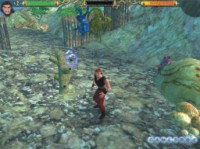 Sinbad:
Legend of the Seven Seas is a simple action game based on the children's
movie of the same title that was quietly released in the summer of
2003. Though the game features some competent gameplay mechanics and
attractive graphics, the extremely short campaign mimics the film's
brief theatrical run a little too well, as it's gone almost before
it starts.
Sinbad:
Legend of the Seven Seas is a simple action game based on the children's
movie of the same title that was quietly released in the summer of
2003. Though the game features some competent gameplay mechanics and
attractive graphics, the extremely short campaign mimics the film's
brief theatrical run a little too well, as it's gone almost before
it starts.
The problems begin before you even open the box. Sinbad:
Legend of the Seven Seas is rated Teen by the ESRB, but clearly, this
is a game aimed at the same younger audiences that saw the PG-rated
film.
Once you get started playing, you'll find that the
developers have done a pretty good job with Sinbad's graphics. Though
the animation isn't always crisp, the vibrant colors and the artistic
settings and character models do resemble the film that the game is
based on. The game's music is appropriately epic, but it's disappointing
that none of the stars (Brad Pitt, Catherine Zeta-Jones, and Michelle
Pfeiffer among them) who lent their voices to the film did any voice
acting for the game. In fact, the game is devoid of any kind of spoken
dialogue whatsoever. The plot is advanced instead by comic book-style
panes and scrolling text in between missions. Like the Teen rating,
the abundance of written text seems somewhat strange for what's basically
a children's game based on an animated cartoon.
The game follows the same plot as the movie. You take
the role of the legendary swashbuckler Sinbad, who has been framed
for the theft of the Book of Peace, which protects the city of Syracuse.
The actual culprit is the goddess of chaos, Eris, and it's up to you
to seek her out and return the magical Book of Peace to its proper
place.
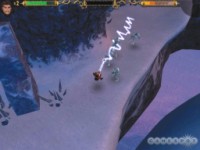 The
gameplay mechanics are surprisingly decent for a movie-licensed game.
You use the mouse to move around by clicking on the area where you
wish to move. Your actions are confined to just three keyboard buttons,
which are mapped to your slashing attack, thrust attack, and block
maneuvers. By using different combinations of these keys, however,
you can unleash special attacks like dives, uppercuts, spin attacks,
and a coup de grâce. Later on, you are able to unleash magical
attacks that eliminate every enemy on the screen at the expense of
your supermeter, which very quickly builds up as you defeat enemies
through more conventional means. The game does a great job at teaching
you these moves, and although the mouse-driven movement can make aiming
your attacks a little awkward at times, for the most part, the controls
feel pretty tight and intuitive.
The
gameplay mechanics are surprisingly decent for a movie-licensed game.
You use the mouse to move around by clicking on the area where you
wish to move. Your actions are confined to just three keyboard buttons,
which are mapped to your slashing attack, thrust attack, and block
maneuvers. By using different combinations of these keys, however,
you can unleash special attacks like dives, uppercuts, spin attacks,
and a coup de grâce. Later on, you are able to unleash magical
attacks that eliminate every enemy on the screen at the expense of
your supermeter, which very quickly builds up as you defeat enemies
through more conventional means. The game does a great job at teaching
you these moves, and although the mouse-driven movement can make aiming
your attacks a little awkward at times, for the most part, the controls
feel pretty tight and intuitive.
Sinbad: Legend of the Seven Seas' biggest problem
as a game is that it's far too short. There are just five different
areas to explore, and each is broken up into a few missions. Unfortunately,
it takes just two hours or so to get through all of it. A child who
is less experienced at games may take a little longer, but the overabundance
of health potions and the frequency with which you can clear the screen
of enemies through magical attacks makes Sinbad a rather easy game
to get through.
